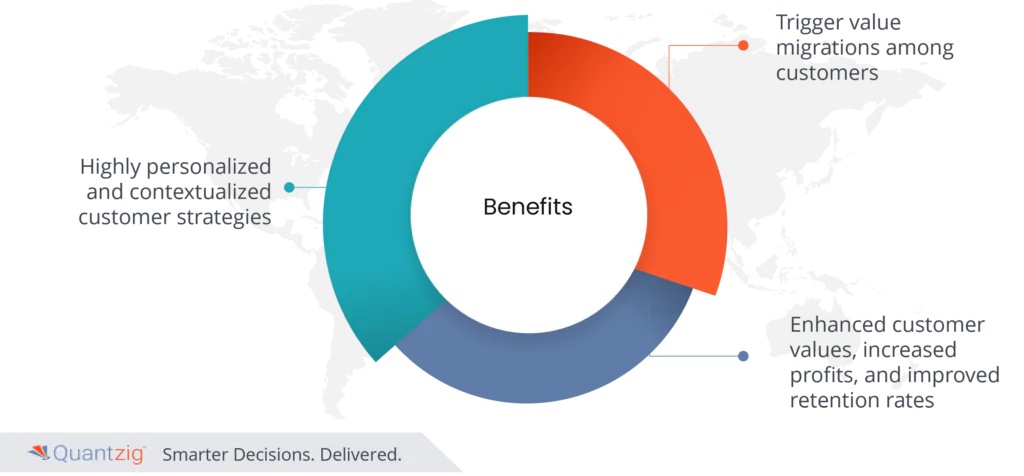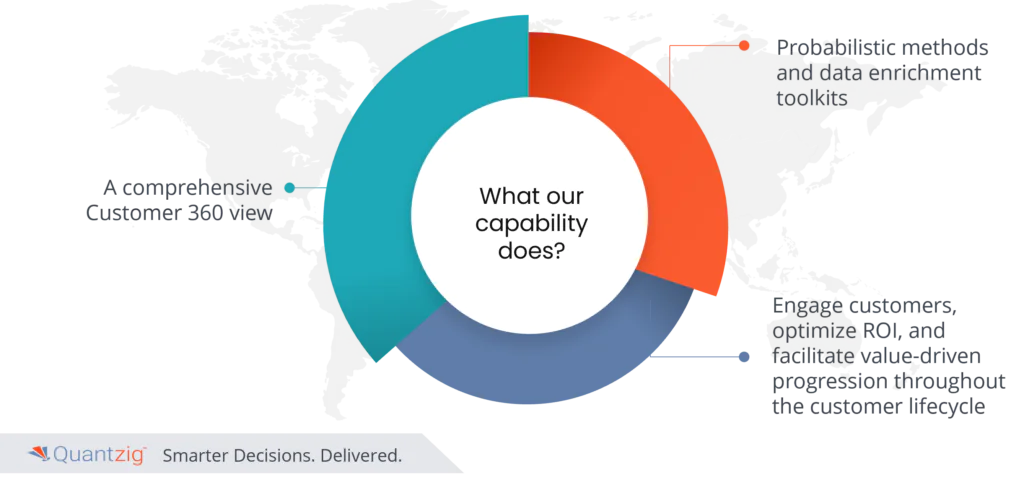Author: Associate Vice President, Analytics and Data Strategy, Quantzig.
The rise of Customer Analytics 3.0 has transformed how companies understand, engage with, and meet customer needs. This piece explores key strategies for implementing Customer Analytics 3.0, from mastering advanced analytics tools to addressing data privacy challenges. We’ll uncover insights that redefine customer-centric business strategies, focusing on data-driven decisions, enhancing customer experience, mapping the customer journey, leveraging tech tools, and aligning with business goals. Additionally, we’ll cover topics like personalization, conversion rate optimization, customer data protection, and effective marketing campaigns, all within the context of GenAI and modern analytics trends.
Book a demo to experience the meaningful insights we derive from data through our customer analytics tools and platform capabilities. Schedule a demo today!
Request a Free DemoTable of Contents
Importance of Customer Analytics 3.0 in Organization:
Succeeding in today’s data-driven business environment requires a strategic combination of advanced customer analytics and tailored initiatives to boost engagement. Quantzig helps businesses thrive by enabling data-driven decisions rooted in comprehensive customer journey insights. With a focus on understanding customer behavior and leveraging cutting-edge technologies like GenAI, Quantzig empowers organizations to deliver exceptional customer experiences while ensuring compliance with privacy regulations.
Quantzig’s Capabilities in a Data-Driven Business:
- Advanced Customer Analytics Solutions: Quantzig provides customized analytics solutions to help businesses gather actionable insights from customer interactions and touchpoints.
- Customer Engagement Strategies: Our experts assist in developing strategic initiatives that optimize customer engagement based on data-driven insights.
- Customer-Centric Approach: We help businesses understand and predict customer behavior, ensuring personalized experiences throughout the customer journey.
- Leveraging Social Media & Technology: Quantzig enhances customer experience by utilizing social media, tech tools, and analytics to drive engagement.
- KPI Tracking & Performance Measurement: We track key performance indicators (e.g., conversion rate, customer reach) to assess success and optimize strategies.
- Robust Analytics Tech Stack: Quantzig integrates advanced technologies, including GenAI, to provide deeper insights into product usage and customer experiences.
- Privacy Compliance: We ensure the ethical use of customer data and full compliance with privacy regulations to safeguard trust.
Next-Gen Customer Analytics Adoption with Quantzig:
- Data Infrastructure: Quantzig helps businesses invest in and optimize data infrastructure for efficient collection, storage, and processing of large datasets.
- Skilled Data Experts: Our team of data scientists and analysts extracts actionable insights using statistical analysis and machine learning.
- Cutting-Edge Tools: We implement the latest analytics tools to enhance an organization’s analytical capabilities.
- Data-Driven Culture & Collaboration: Quantzig fosters a data-centric culture by securing executive buy-in and encouraging cross-functional collaboration.
The synergy between advanced analytics adoption and precise strategy execution empowers organizations to thrive in the era of data-driven decision-making, fostering long-term customer relationships and sustainable business growth.
Experience the advantages firsthand by testing a customized complimentary pilot designed to address your specific customer analytics requirements. Pilot studies are non-committal in nature.
Request a Free PilotChallenges faced while implementing Customer Analytics 3.0:
Transforming complex customer data into actionable insights is very important for driving engagement and fostering loyalty. This involves analyzing data from various touchpoints, creating a 360-degree view of each customer, and using advanced analytics to develop personalized recommendations that enhance customer experience and drive business success.
Challenges in Customer Data Management:
- Re-engaging disengaged subscribers and refining customer segment
- Curating, structuring, and attributing customer data across multiple channels
- Harmonizing data into a cohesive, unified form for comprehensive insights
- Ensuring collaboration and communication among teams for alignment
- Managing resources, skills, and budgets while adhering to timelines
- Analyzing both quantitative and qualitative data to inform strategies
- Identifying patterns across customer journeys for personalized offers
- Tracking KPIs, cart abandonment, and customer behaviors for improvements
Benefits of implementing Customer Analytics 3.0:

Highly personalized and contextualized customer strategies are key to unlocking exceptional business outcomes. By tailoring interactions and offerings to each customer’s unique preferences and behaviors, businesses can significantly boost Return on Investment (ROI). When customers feel understood and catered to, they are more likely to engage, spend more, and show loyalty. Additionally, personalized strategies can lead to value migrations, where customers move from lower to higher-value segments, enhancing overall profitability.
Personalized Strategies for High ROI:
- Tailor interactions and offerings to individual customer needs
- Enhance customer engagement, spending, and loyalty
- Encourage value migration from lower to higher-value segments
Tools and Data Sources for Personalization:
- Analyze web analytics: clicks, social listening, on-site activity, sales metrics
- Use surveys, interviews, and focus groups for detailed customer insights
- Track engagement metrics: email open rates, blog reads, trial sign-ups
Combining Quantitative and Qualitative Data:
- Integrate sales data, adoption metrics, and customer satisfaction surveys
- Utilize call center logs to understand pain points
- Combine statistical data with rich customer feedback for comprehensive insights
Enhancing Engagement with AI and Analytics Tools:
- Use AI technologies like LLMs for personalized interactions
- Integrate tools such as Adobe Analytics, Databricks, Snowflake, and Tealium
- Monitor social media and user comments for real-time insights
Building a Robust Data Infrastructure:
- Ensure compliance with privacy regulations
- Develop a centralized data warehouse for comprehensive analysis
- Collaborate across teams: UX/UI designers, data analysts, customer service
Fostering Long-Term Relationships and Growth:
- Address churn rates and encourage repeat purchases
- Leverage cross-functional teams for effective customer success initiatives
- Align strategies with customer behaviors to drive sustainable growth
Enhancing Customer Engagement with Quantzig’s Advanced Strategies
Quantzig specializes in delivering tailored solutions that harness the power of data to engage customers more effectively, drive personalization, and optimize overall marketing efforts.

Executing Winning Customer Strategies with Quantzig:
- Tailored Action Plans: Quantzig crafts personalized action plans based on individual customer profiles to ensure targeted engagement.
- Granular Customer Insights: Our solutions enable businesses to refine strategies by delving into the specifics of customer journeys and touchpoints.
- KPI-Driven Decisions: We focus on key performance indicators like conversion rates to make data-driven decisions that enhance customer engagement.
- Ethical Use of Customer Data: Quantzig ensures responsible use of customer data, strictly adhering to privacy regulations.
- Personalization & Marketing: We implement personalization strategies that align with your business goals and marketing initiatives.
- GenAI Integration: By integrating GenAI into the analytics tech stack, we offer deeper insights into product experiences and monitor usage effectively.
By leveraging Quantzig’s expertise in customer analytics and personalized strategy development, businesses can achieve a comprehensive understanding of their customers and enhance their engagement efforts. Our focus on tailored action plans, ethical data use, and advanced technologies like GenAI ensures that you are equipped to drive meaningful interactions, customer engagement and secure a competitive edge in the marketplace.
Get started with your complimentary trial today and delve into our platform without any obligations. Explore our wide range of customized, data driven customer analytical solutions built across the analytical maturity levels.
Start your Free TrialConclusion:
In the relentless pursuit of excellence, organizations must embrace the transformative force of Customer Analytics 3.0. As we conclude this exploration of success strategies for its implementation, we find ourselves at the precipice of a new era. The fusion of cutting-edge technology, data mastery, and customer-centricity promises unprecedented opportunities. The power to understand, predict, and engage with customers on a deeply personal level is within reach. Those who seize this moment, unlocking the true potential of their data, will not merely succeed; they will redefine the very essence of business excellence. The journey towards Customer Analytics 3.0 is not an option but an imperative for those who aspire to lead, innovate, and thrive in the dynamic landscape of tomorrow.
Additionally, businesses must focus on driving repeat purchases through personalized strategies and utilizing data insights to foster customer loyalty. Incorporating relevant terms and visually appealing stock images can further enhance communication and engagement with customers.



